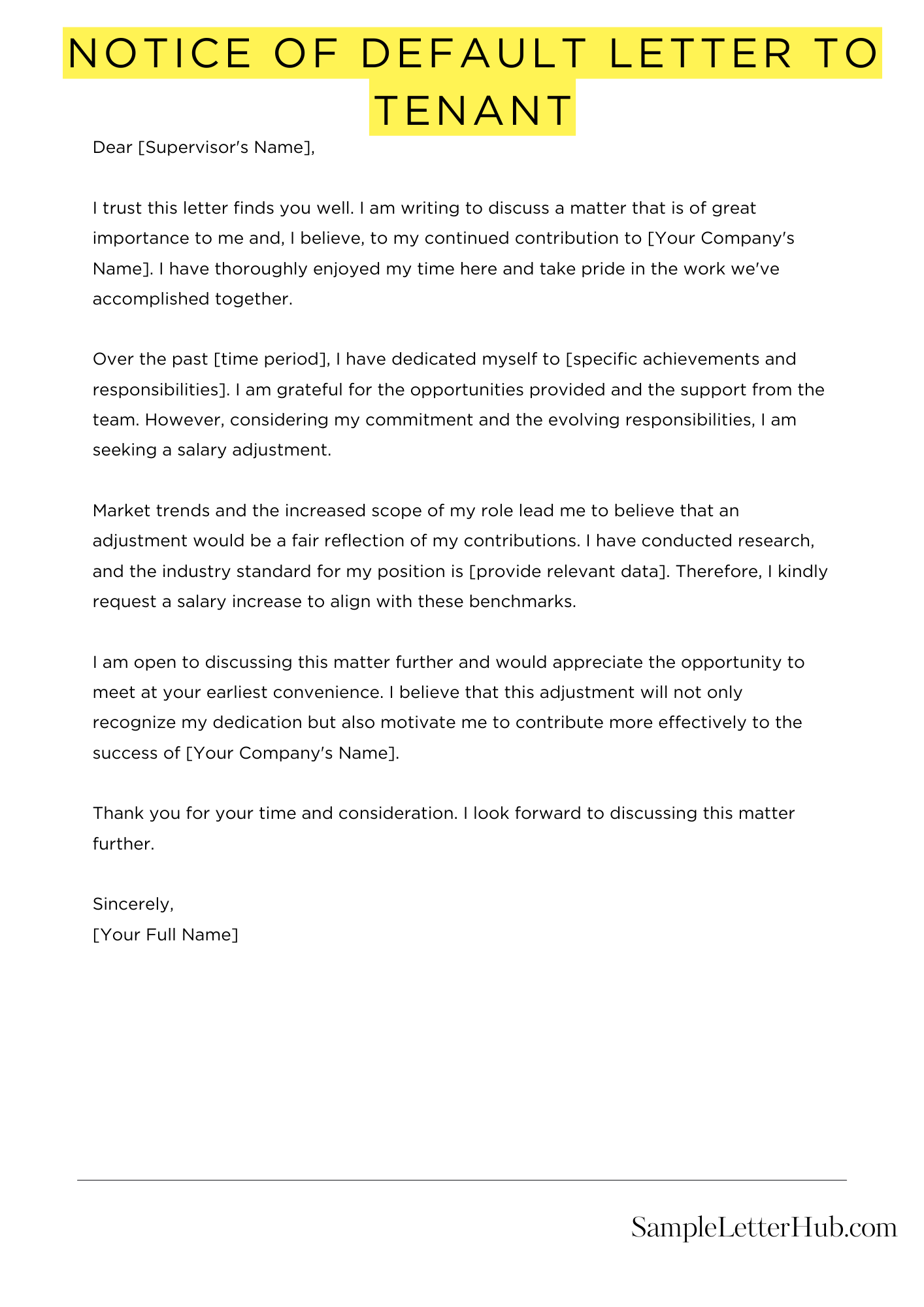A Notice of Default Letter to Tenant is a formal letter sent by a landlord to a tenant who has violated the terms of their lease agreement. The purpose of the letter is to inform the tenant of the default, provide them with an opportunity to cure the violation, and outline the consequences if they fail to do so.
In this article, we will provide you with several templates, examples, and samples of Notice of Default Letters to Tenant. These templates are designed to make it easy for you to draft your own letter, regardless of the specific circumstances of your case.
Whether you are a landlord or a tenant, it is important to understand the legal implications of a Notice of Default Letter. By providing you with these templates, we hope to help you resolve any lease violations quickly and efficiently.
Notice of Default Letter to Tenant
Dear [Tenant Name],
This letter serves as a formal notice of default under the terms of your lease agreement dated [Lease Date]. You have failed to fulfill your obligation to pay rent for the month of [Month]. The outstanding balance is [Amount].
As per the lease agreement, rent is due on the [Due Date] of each month. Your failure to pay rent on time constitutes a material breach of the lease.
You are hereby required to pay the outstanding rent within [Number] days of receipt of this notice. Failure to do so may result in further legal action, including eviction proceedings.
Please contact us immediately to discuss this matter and make arrangements for payment. We are available at [Phone Number] or [Email Address].
Sincerely,
[Your Name]

How to Write a Notice of Default Letter to a Tenant
A Notice of Default is a formal letter sent by a landlord to a tenant who has breached their lease agreement. It outlines the specific violations and provides the tenant with a deadline to rectify the situation. Writing an effective Notice of Default letter is crucial for protecting the landlord’s rights and initiating legal proceedings if necessary.
1. Identify the Breach
Clearly state the specific provisions of the lease agreement that the tenant has violated. Provide specific examples and evidence to support your claims. Avoid using vague or general language.
2. Specify the Deadline
Give the tenant a reasonable amount of time to remedy the breach. The deadline should be specific and provide the tenant with ample opportunity to address the issue. Consider the severity of the violation and the tenant’s history of compliance.
3. Outline the Consequences
Explain the consequences of failing to rectify the breach within the specified deadline. This may include eviction, termination of the lease, or additional penalties as outlined in the lease agreement.
4. Request a Response
Request a written response from the tenant within a specified timeframe. This will provide the tenant with an opportunity to explain their actions or provide evidence of compliance.
5. Document the Notice
Keep a copy of the Notice of Default letter for your records. Consider sending the letter via certified mail or hand-delivering it to the tenant to ensure receipt.
6. Consider Legal Advice
If the tenant fails to respond or remedy the breach within the specified deadline, you may need to seek legal advice. An attorney can assist you in drafting a formal demand letter or initiating eviction proceedings.
7. Maintain Professionalism
Throughout the process, maintain a professional and respectful tone in your communications with the tenant. Avoid using inflammatory language or making threats. The goal is to resolve the issue amicably while protecting your legal rights.
FAQs about Notice Of Default Letter To Tenant
What is a Notice of Default Letter to Tenant?
A Notice of Default Letter to Tenant is a formal letter sent by a landlord to a tenant who has breached their lease agreement. It outlines the specific violations or defaults committed by the tenant and provides a deadline for the tenant to rectify the situation.
What are the grounds for issuing a Notice of Default Letter to Tenant?
Common grounds for issuing a Notice of Default Letter to Tenant include non-payment of rent, violation of lease terms (e.g., unauthorized subletting), causing damage to the property, or engaging in illegal activities on the premises.
What should a Notice of Default Letter to Tenant include?
A Notice of Default Letter to Tenant should clearly state the default(s) committed by the tenant, specify the lease provisions that have been violated, and provide a reasonable deadline for the tenant to remedy the situation. It should also outline the potential consequences of failing to cure the default, such as eviction or legal action.
What are the legal implications of a Notice of Default Letter to Tenant?
A Notice of Default Letter to Tenant serves as a formal notice of the tenant’s breach of lease and provides them with an opportunity to rectify the situation. If the tenant fails to cure the default within the specified deadline, the landlord may initiate legal proceedings, such as eviction or a breach of contract lawsuit.
What should a tenant do upon receiving a Notice of Default Letter?
Upon receiving a Notice of Default Letter, the tenant should carefully review the allegations and consult with an attorney if necessary. They should promptly address the default(s) outlined in the letter and provide evidence of their efforts to the landlord. If the tenant is unable to cure the default, they should negotiate with the landlord to find a mutually acceptable solution, such as a payment plan or a revised lease agreement.

